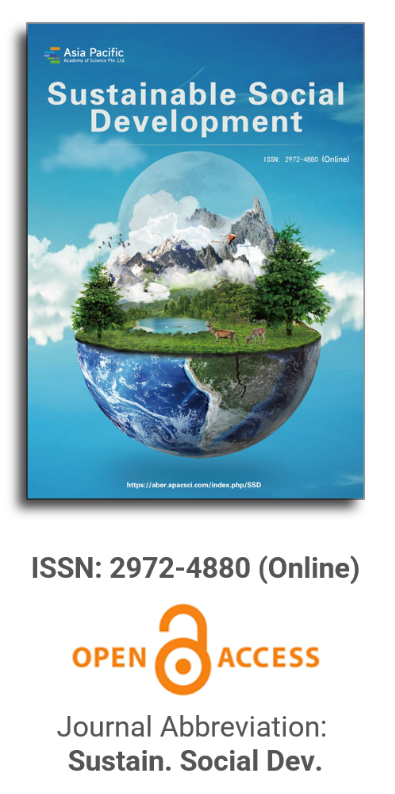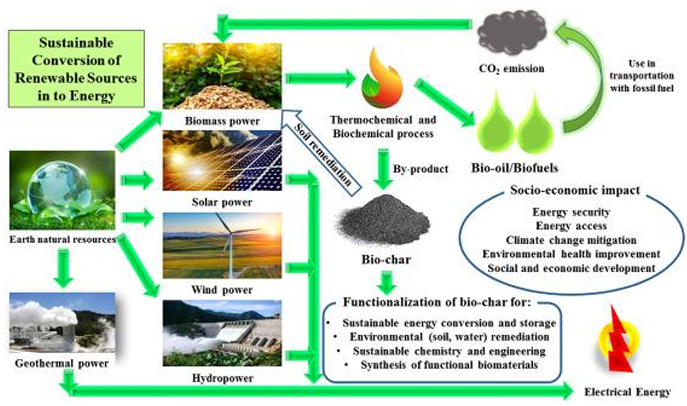
Asia Pacific Academy of Science Pte. Ltd. (APACSCI) specializes in international journal publishing. APACSCI adopts the open access publishing model and provides an important communication bridge for academic groups whose interest fields include engineering, technology, medicine, computer, mathematics, agriculture and forestry, and environment.

Social enterprises transformation and its effects on socio-economic development in developed and developing countries
Vol 2, Issue 4, 2024
Download PDF
Abstract
In the twenty-first century, the idea of social enterprises influencing global socio-economic growth has gained much attention and has momentous implications for the modern economy. Both emerging and developed countries frequently observe its considerable impact on their economy as social enterprise transformation has such a wide-ranging effect on socioeconomic growth. The purpose of this study is to present evidence of the impacts of global social enterprise transformation on global socio-economic development. However, there are no official statistics available on the effects of the transformation of global social companies on global socio-economic development. The debate in this research demonstrates how social enterprise transform like a collaboration between the private, public, and civil sectors, continually honing their approach to their goals, based on the review of several case studies of social enterprises from around the world. Revamp, acquisitions, and improved performance are all efforts to achieve sustainable societal progress in the fields of economics, culture, and politics. The results indicate that social enterprises transformation causes the socio-economic development of the world. Our results also suggest that social enterprise transformation impact and outcome are more significant in developed countries than in developing countries.
Keywords
References
- World Economic Forum. The Davos report: Highlights, outcomes and next steps from the 2004 World Economic Forum. Available online: http://www.weforum.org/summitreports (accessed on 2 May 2024).
- Hartigan P. The Challenge for Social Entrepreneurship. Schwab Foundation for Social Entrepreneurship Global Summit; 2004.
- Alter SK. Case studies in social enterprise: Counterpart international is experience. Counterpart International; 2002.
- Prakash A. Beyond Seattle: globalization, the nonmarket environment and corporate strategy. Review of International Political Economy. 2002; 9(3): 513-537. doi: 10.1080/09692290210150707
- Alvord SH, Brown LD, Letts CW. Social Entrepreneurship and Societal Transformation. The Journal of Applied Behavioral Science. 2004; 40(3): 260-282. doi: 10.1177/0021886304266847
- Berger IE, Cunningham PH, Drumwright ME. Social Alliances: Company/Nonprofit Collaboration. California Management Review. 2004; 47(1): 58-90. doi: 10.2307/41166287
- Sakarya S. Social alliances: Business and social enterprise collaboration for social transformation. Journal of Business Research. 2012. doi: 10.1016/j.jbusres.2012.02.012
- Maguirre MV, Ruelas GC, Torre CGDL. Women empowerment through social innovation in indigenous social enterprises. RAM Revista de Administração Mackenzie. 2016; 17(6): 164-190. doi: 10.1590/1678-69712016/administracao.v17n6p164-190
- Loku AE. Social Enterprises Like the Right Step for Economic Development for Kosovo. European Journal of Marketing and Economics. 2018; 1(1): 26. doi: 10.26417/ejme.v1i1.p26-31
- Seanor P, Meaton J. Making sense of social enterprise. Social Enterprise Journal. 2007; 3(1): 90-100. doi: 10.1108/17508610780000724
- Young DR. Alternative perspectives on social enterprise. In: Cordes JJ, Steuerle E (editors). Nonprofits and Business. Urban Institute Press; 2009. pp. 21-46.
- Pestoff V. Beyond the Market and the State. Ashgate, Adershot; 1998.
- Cambridge Dictionary. Transformation. Available online: https://dictionary.cambridge.org/dictionary/english/transformation (accessed on 2 May 2024).
- Grimes MG, McMullen JS, Vogus TJ, Miller TL. Studying the origins of social entrepreneurship: Compassion and the role of embedded agency. Academy of management review. 2013; 38(3): 460-463.
- Drolet J, Sampson T, Burstein M, et al. The role of employers in bridging newcomers’ absorption and integration in the Canadian labour market: A Knowledge Synthesis Project. Available online: http://p2pcanada.ca/wp-content/blogs.dir/1/files/2014/03/The-Role-of-Employers-in-Bridging-Newcomers-Absorption-and-Integration-in-the-Canadian-Labour-Market-A-Knowledge-Synthesis-Project.pdf (accessed on 2 May 2024)
- United Nations. Conferences | Environment and sustainable development. https://www.un.org/en/conferences/environment/newyork2005 (accessed on 2 May 2024).
- Roche D. The people of Paris, twenty years on (French). In: Robert JL, Tartakowsky D (editors). Paris the People (French). Éditions de la Sorbonne; 1999. pp. 21-36. doi: 10.4000/books.psorbonne.1266
- Burdge RJ, Vanclay F. Social impact assessment: a contribution to the state of the art series. Impact Assessment. 1996; 14(1): 59-86. doi: 10.1080/07349165.1996.9725886
- GPSIA. The Inter-Organizational Committee on Guidelines and Principles for Social Impact Assessment. U.S. Department of Commerce National Oceanic and Atmospheric Administration; 1994.
- Long PT, Perdue RR. The Economic Impact of Rural Festivals and Special Events: Assessing the Spatial Distribution of Expenditures. Journal of Travel Research. 1990; 28(4): 10-14. doi: 10.1177/004728759002800403
- Morin Dalton T. An approach for integrating economic impact analysis into the evaluation of potential marine protected area sites. Journal of Environmental Management. 2004; 70(4): 333-349. doi: 10.1016/j.jenvman.2003.12.012
- Braun BM. Measuring the influence of public authorities through economic impact analysis: the case of port canaveral. Policy Studies Journal. 1990; 18(4): 1032-1044. doi: 10.1111/j.1541-0072.1990.tb00869.x
- Becker HA. Social impact assessment. European Journal of Operational Research. 2001; 128(2): 311-321.
- Sztompka P. The Sociology of Social Change. Wiley-Blackwell; 1994.
- Paton R. Managing and Measuring Social Enterprises. Sage Publications; 2003. doi: 10.4135/9781446221327
- Borzaga C, Defourny J. The Emergence of Social Enterprise. Routledge; 2001.
- Fowler A. NGDOs as a moment in history: beyond aid to social entrepreneurship or civic innovation? Third World Quarterly. 2000; 21(4): 637-654.
- Frumkin P. On Being Nonprofit. Harvard University Press; 2002.
- Boschee J. Eight basic principles for nonprofit entrepreneurs. Nonprofit World. 2001; 19(4): 15-18.
- Mair J, Marti I. Social entrepreneurship: What are we talking about? A framework for future research. Available online: https://www.researchgate.net/publication/4817078_Social_entrepreneurship_What_are_we_talking_about_A_framework_for_future_research (accessed on 2 May 2024).
- Sharir M, Lerner M. Gauging the success of social ventures initiated by individual social entrepreneurs. Journal of World Business. 2006; 41(1): 6-20.
- Vega G, Kidwell RE. Toward a typology of new venture creators: similarities and contrasts between business and social entrepreneurs. New England journal of entrepreneurship. 2007; 10(2): 15-28.
- Holt DH. Entrepreneurship: New Venture Creation. Prentice Hall; 1992.
- Almeida DF. Social Ventures and Social Entrepreneurs: Factors for Success [PhD thesis]. ISCTE-Instituto Universitario de Lisboa (Portugal); 2010.
- Drayton W. The citizen sector: Becoming as entrepreneurial and competitive as business. California management review. 2002; 44(3): 120-132.
- Touboul S, Roulet TJ. How to Turn entrepreneurs into social entrepreneurs? A challenge for developing countries. Journal of Social Business. 2011; (2).
- Martin RL, Osberg S. Social entrepreneurship: the case for definition. Stanford Social Innovation Review. 2007; 1: 29-39.
- Zahra SA, Gedajlovic E, Neubaum DO, Shulman JM. A typology of social entrepreneurs: Motives, search processes and ethical challenges. Journal of business venturing. 2009; 24(5): 519-532.
- Hossain DM. Social entrepreneurs in Bangladesh. International Journal of Research in Commerce, IT & Management. 2007; 2(9): 7-12.
- Henton DC, Melville J, Walesh K. Grassroots Leaders for a New Economy: How Civic Entrepreneurs are Building Prosperous Communities. Jossey-Bass; 1997.
- Phills JA, Deiglmeier K, Miller DT. Rediscovering social innovation. Stanford Social Innovation Review. 2008; 6(4): 34-43.
- Dorado S. Social entrepreneurial ventures: different values so different process of creation, no? Journal of Developmental Entrepreneurship. 2006; 11(4): 319-343.
- Mair J, Martí I. Entrepreneurship in and around institutional voids: a case study from Bangladesh. Journal of Business Venturing, forthcoming. 2009.
- Martí I, Mair J. Bringing change into the lives of the poor: entrepreneurship outside traditional boundaries. In: Lawrence T, Suddaby R, Leca B (editors). Institutional Work, New York, United States and Cambridge, United Kingdom, Cambridge University Press. 2009.
- Peredo AM, Chrisman JJ. Toward a theory of community-based enterprise. Academy of Management Review. 2006; 31(2): 309-328.
- Johannisson B, Nilsson A. Community entrepreneurs: networking for local development. Entrepreneurship & Regional Development. 1989; 1(1): 3-19.
- Mair J. Social entrepreneurship: Taking Stock and Looking Ahead. In: Handbook of Research on Social Entrepreneurship. Edward Elgar Publishing; 2010.
- Kukaj D. Impact of unemployment on economic growth: Evidence from Western Balkans. European Journal of Marketing and Economics. 2018; 1(1): 9-17.
- Hossain S, Saleh MA, Drennan J. A critical appraisal of the social entrepreneurship paradigm in an international setting: a proposed conceptual framework. International Entrepreneurship and Management Journal. 2016; 13(2): 347-368. doi: 10.1007/s11365-016-0400-0
- Auerswald PE. Creating social value. Stanford Social Innovation Review. 2009; 7: 51-55.
- Mulgan G. The Process of Social Innovation. Innovations: Technology, Governance, Globalization. 2006; 1(2): 145-162. doi: 10.1162/itgg.2006.1.2.145
- Dees JG, Anderson BB. Framing a theory of social entrepreneurship: Building on two schools of practice and thought. In: Mosher-Williams R (editor). Research on Social Entrepreneurship: Understanding and Contributing to an Emerging Field. The Aspen Institute; 2006. pp. 39-66.
- Hertie School. German social enterprises: collaborators and innovators. Available online: https://www.hertie-school.org/en/news/news/detail/content/german-social-enterprises-collaborators-and-innovators (accessed on 2 May 2024).
- Japanese Consumers’ Co-operate Union. Co-op Tohoku receives a letter of appreciation from Minamisanriku Town for their reconstruction assistance following the Great East Japan Earthquake. Available online: https://jccu.coop/eng/news/2022/04/co-op-tohoku-receives-a-letter-of-appreciation-from-minamisanriku-town-for-their-reconstruction-assi.html (accessed on 2 May 2024).
- World Health Organization. Health risk assessment from the nuclear accident after the 2011 Great East Japan Earthquake and Tsunami: Based on a preliminary dose estimation Available online: https://iris.who.int/bitstream/handle/10665/78218/9789241505130_eng.pdf?sequence=1 (accessed on 2 May 2024).
- Gatesfoundation. Entrepreneurial Training for Innovative Communities. Available online: https://www.gatesfoundation.org/about/committed-grants/2019/11/inv003297 (accessed on 2 May 2024).
- Available online: https://www.socialenterprise.org.uk/winners-of-the-2018-uk-social-enterprise-awards/ (accessed on 2 May 2024).
- Arthur WB. Competing Technologies, Increasing Returns, and Lock-In by Historical Events. The Economic Journal. 1989; 99(394): 116. doi: 10.2307/2234208
- Ramani SV, SadreGhazi S, Gupta S. Catalysing innovation for social impact: The role of social enterprises in the Indian sanitation sector. Technological Forecasting and Social Change. 2017; 121: 216-227. doi: 10.1016/j.techfore.2016.10.015
- Ramani SV, SadreGhazi S, Gupta S. Catalysing innovation for social impact: The role of social enterprises in the Indian sanitation sector. Technological Forecasting and Social Change. 2017; 121: 216-227.
- Ramadan R. Social Enterprises and Employment: Case Studies from Egypt. Available online: https://south.euneighbours.eu/wp-content/uploads/2022/07/emnes_wp_053_social_enterprises_employment_egypt-1.pdf (accessed on 2 May 2024).
- United Nations Development Programme. What are the Sustainable Development Goals? Available online: https://www.undp.org/sustainable-development-goals (accessed on 2 May 2024).
Supporting Agencies
Copyright (c) 2024 Li Qi, Hero Rana Barua Mito, Mousumi Akter
License URL: https://creativecommons.org/licenses/by/4.0

This site is licensed under a Creative Commons Attribution 4.0 International License (CC BY 4.0).

Prof. Kittisak Jermsittiparsert
University of City Island, Cyprus






It is with deep regret that we announce the cancellation of the Forum on Sustainable Social Development & Computing and Artificial Intelligence, originally scheduled for June 15, 2025.

